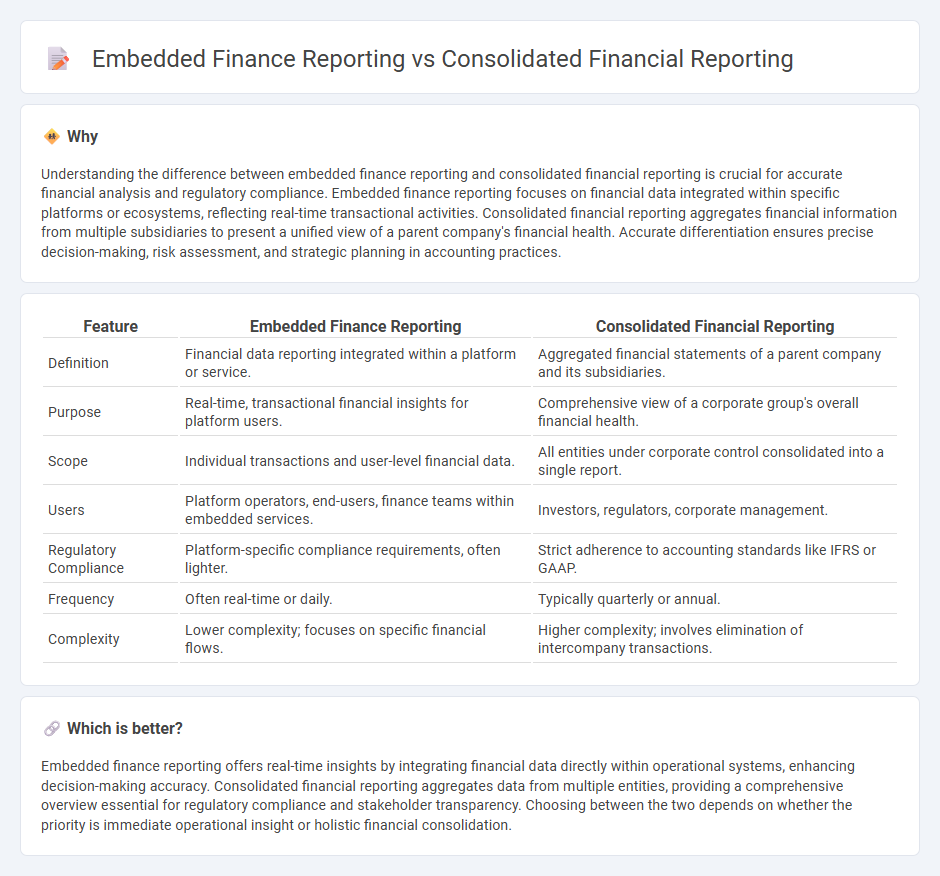
Embedded finance reporting integrates financial services directly into non-financial platforms, offering real-time data and seamless transaction visibility tailored for specific business operations. Consolidated financial reporting aggregates financial information from multiple subsidiaries or divisions into a single comprehensive statement, providing a holistic view of the organization's financial health. Explore the key differences and applications to optimize your financial reporting strategy.
Why it is important
Understanding the difference between embedded finance reporting and consolidated financial reporting is crucial for accurate financial analysis and regulatory compliance. Embedded finance reporting focuses on financial data integrated within specific platforms or ecosystems, reflecting real-time transactional activities. Consolidated financial reporting aggregates financial information from multiple subsidiaries to present a unified view of a parent company's financial health. Accurate differentiation ensures precise decision-making, risk assessment, and strategic planning in accounting practices.
Comparison Table
| Feature | Embedded Finance Reporting | Consolidated Financial Reporting |
|---|---|---|
| Definition | Financial data reporting integrated within a platform or service. | Aggregated financial statements of a parent company and its subsidiaries. |
| Purpose | Real-time, transactional financial insights for platform users. | Comprehensive view of a corporate group's overall financial health. |
| Scope | Individual transactions and user-level financial data. | All entities under corporate control consolidated into a single report. |
| Users | Platform operators, end-users, finance teams within embedded services. | Investors, regulators, corporate management. |
| Regulatory Compliance | Platform-specific compliance requirements, often lighter. | Strict adherence to accounting standards like IFRS or GAAP. |
| Frequency | Often real-time or daily. | Typically quarterly or annual. |
| Complexity | Lower complexity; focuses on specific financial flows. | Higher complexity; involves elimination of intercompany transactions. |
Which is better?
Embedded finance reporting offers real-time insights by integrating financial data directly within operational systems, enhancing decision-making accuracy. Consolidated financial reporting aggregates data from multiple entities, providing a comprehensive overview essential for regulatory compliance and stakeholder transparency. Choosing between the two depends on whether the priority is immediate operational insight or holistic financial consolidation.
Connection
Embedded finance reporting integrates financial data from various non-financial platforms, enhancing real-time transaction visibility. Consolidated financial reporting aggregates these diverse data points across subsidiaries or business units, providing a comprehensive financial overview. Together, they streamline financial analysis by combining granular embedded finance insights with high-level consolidated reports.
Key Terms
Intercompany Eliminations
Consolidated financial reporting requires careful intercompany eliminations to avoid double counting of transactions and balances between subsidiaries, ensuring accurate reflection of the group's financial position. Embedded finance reporting, which integrates financial services within non-financial platforms, demands precise tracking of intercompany transfers to maintain transparency and regulatory compliance. Explore the detailed methodologies and best practices in managing intercompany eliminations for both reporting approaches.
Minority Interest
Consolidated financial reporting aggregates the financial statements of a parent company and its subsidiaries, prominently highlighting minority interest as the portion of equity not owned by the parent, ensuring transparent representation of non-controlling shareholders. Embedded finance reporting integrates financial services into non-financial platforms, requiring nuanced tracking of minority interests within joint ventures or partnerships where financial services are embedded. Explore how accurate minority interest reporting influences financial transparency and stakeholder decision-making.
API Integration
Consolidated financial reporting aggregates financial data from multiple subsidiaries into a single comprehensive statement, ensuring accuracy and regulatory compliance across the organization. Embedded finance reporting leverages API integration to seamlessly incorporate financial services within non-financial platforms, enabling real-time transaction data and enhanced user experience. Explore how API-driven solutions transform financial reporting frameworks for greater efficiency and insight.
Source and External Links
Guide to Consolidated Multi-Group Financial Reporting - Consolidated financial statements combine the financial position and performance of a parent company and its subsidiaries, eliminating intercompany transactions to present the group as a single economic entity.
Preparing Consolidated Financial Statements: A Step-by-Step Guide - The process involves identifying all entities controlled by the parent, gathering their financial data, and combining them into unified reports while ensuring compliance with accounting standards.
Consolidated Financial Statements Guide - Consolidated statements provide a complete view of a parent company's financial health by aggregating the balance sheets, income statements, and cash flow statements of all subsidiaries, offering stakeholders a true picture of the entire organization's performance.
 dowidth.com
dowidth.com